Sew Good: Christine Bieselin Clark ’93
Friday, 8 November 2013
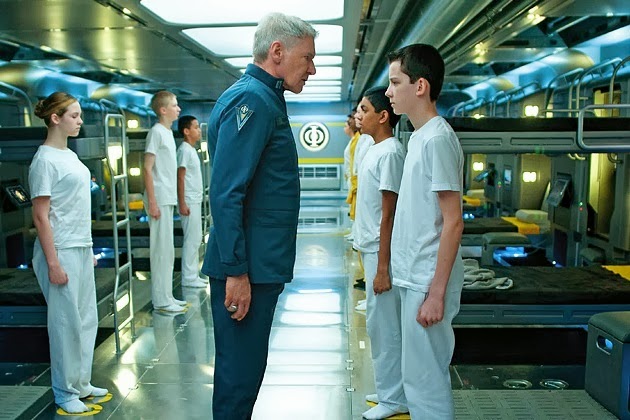
After serving as an assistant on five films to Michael Wilkinson (Man of Steel) and being a co-costume designer with him on Tron: Legacy (2010), Christine Bieselin Clark (The Maze Runner) has been taught well by her mentor. “The most valuable thing I ever learnt from Michael is to remain calm at all times. We are surrounded by endless curveballs and even when you are beyond being overwhelmed, you must, ‘remain calm at all times.’” Having previously worked on Rendition (2007), Bieselin Clark was well acquainted with filmmaker Gavin Hood who recruited her to be his costume designer for the cinematic adaptation of Ender’s Game (2013). “When I sat with Gavin for the first time, in an early concept phase of EG, and showed him my presentation it was like no time had passed. My ideas were completely in line with Gavin’s and we had the same philosophy about the costumes for his film.” The experience on the Tron sequel proved to be useful. “We used many different techniques on TL to build our costumes, ranging from the tradition, existing special effects costuming on to innovating new costume technologies. I have learnt a lot about what works well for the time and financial investment, and what does not; that enabled me to strategize on a plan for EG that would suit our time and budgetary limitations while maximizing the design impact.”
Tron: Legacy (2010), Christine Bieselin Clark (The Maze Runner) has been taught well by her mentor. “The most valuable thing I ever learnt from Michael is to remain calm at all times. We are surrounded by endless curveballs and even when you are beyond being overwhelmed, you must, ‘remain calm at all times.’” Having previously worked on Rendition (2007), Bieselin Clark was well acquainted with filmmaker Gavin Hood who recruited her to be his costume designer for the cinematic adaptation of Ender’s Game (2013). “When I sat with Gavin for the first time, in an early concept phase of EG, and showed him my presentation it was like no time had passed. My ideas were completely in line with Gavin’s and we had the same philosophy about the costumes for his film.” The experience on the Tron sequel proved to be useful. “We used many different techniques on TL to build our costumes, ranging from the tradition, existing special effects costuming on to innovating new costume technologies. I have learnt a lot about what works well for the time and financial investment, and what does not; that enabled me to strategize on a plan for EG that would suit our time and budgetary limitations while maximizing the design impact.”

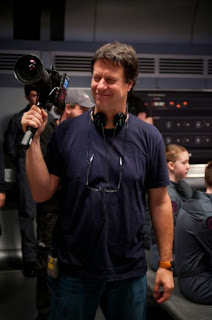 “Gavin is a true artist,” believes Christine Bieselin Clark. “He identifies with the material on a deeply emotional level and I respond strongly to that. We had many conversations in the beginning where we discussed the look of the characters using adjectives to describe how they should feel more than how they should look. From that understanding of the intention, I was able to bring visuals to Gavin that would interpret those feelings into costumes.” Bieselin Clark was familiar with the source material. “I had read Ender’s Game in college and had strong memories of the characters and the impact they had on me. I did refer to specific descriptions in the text to help guide the look of the film but I intentionally did not read the book[s] again prior to prepping the film. I wanted the impact of my first read to be a guiding force and then to allow the script to drive my design process.” In order to maintain a unified look discussions were had with Ben Procter and Sean Haworth (The Thing) who were responsible for the production design. “In the beginning concepts for the film, it was just the three of us with Gavin. Sean and Ben had done a lot of concept art prior to my coming on board so that informed the world in which I was designing into. Ours was an on-going collaboration throughout.”
“Gavin is a true artist,” believes Christine Bieselin Clark. “He identifies with the material on a deeply emotional level and I respond strongly to that. We had many conversations in the beginning where we discussed the look of the characters using adjectives to describe how they should feel more than how they should look. From that understanding of the intention, I was able to bring visuals to Gavin that would interpret those feelings into costumes.” Bieselin Clark was familiar with the source material. “I had read Ender’s Game in college and had strong memories of the characters and the impact they had on me. I did refer to specific descriptions in the text to help guide the look of the film but I intentionally did not read the book[s] again prior to prepping the film. I wanted the impact of my first read to be a guiding force and then to allow the script to drive my design process.” In order to maintain a unified look discussions were had with Ben Procter and Sean Haworth (The Thing) who were responsible for the production design. “In the beginning concepts for the film, it was just the three of us with Gavin. Sean and Ben had done a lot of concept art prior to my coming on board so that informed the world in which I was designing into. Ours was an on-going collaboration throughout.”

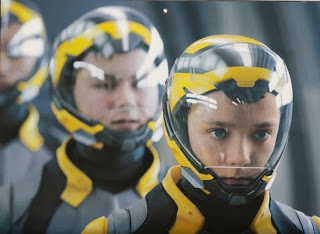
“There are no purely digital costumes in the film,” reveals Christine Bieselin Clark. “Any costumes, such as the flash suits in the battle room, that were to be digitally replicated were built and then scanned for data reference.” Various military uniforms from around the world were researched to produce the outfits worn by the members of the International Fleet. “We wanted a military that felt international as well as future forward. I researched military regimes from all over the world, past and present. What we’ve created is an extremely sleek, elegantly stylized military uniform system that doesn’t specifically call out any region.” The clothes had to be futuristic but also relatable. “That was definitely a goal of mine, to make the look of the costumes be future forward without getting in the way of the action or the emotion of the scenes. I never wanted to pull focus from the actors in their performance so there is a lot of subtlety to the design.”
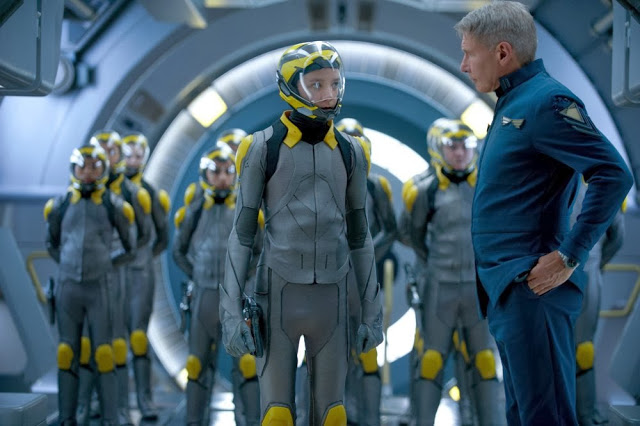

“We had at least doubles for each cast member and also for the core stunt group,” states Christine Bieselin Clark. “Some cast had three or four of each costume. There were hundreds and hundreds of costumes!” Many Flash Suits and helmets needed to be made. “To create a suit that is visually impressive, functional for the action, durable and not entirely torturous to wear, while keeping up with the changing stature of our young actors was a challenge to say the least! I was very aware of what we were up against from the beginning so the Flash Suits are designed to compensate for growth. We built the suit in two pieces – jacket and pants. The design of the pants continues up under the jacket for a bit so that if the body gets longer, the design lines will follow the growth. The same concept was used with gloves that are longer that go over the top of the sleeve and boots that ride over the bottom of the pants, a tricky business. As for the wire work, we designed lines into the suit where pick points usually occur for wire harnesses. There is a side back design line to the jacket, as well as an area on the upper thigh and the jacket line curves over the hip to allow for wires to move freely without destroying the costume completely.”
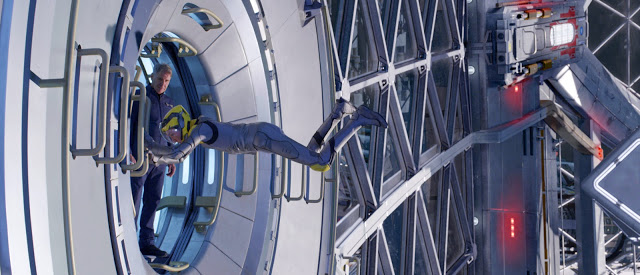
“The battle school uniforms are a take on the classic flight suit which we called a training suit,” explains Bieselin Clark.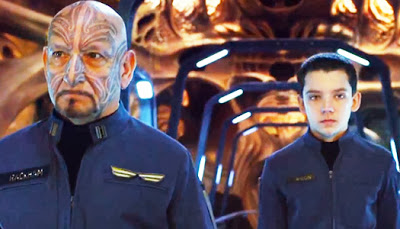 “They are one piece cover all style suits that the actor steps into and zips up the front. This just felt utilitarian, practical and would help achieve a look of uniformity amongst the trainees. There is a dot pattern on the name bars for all of the actors. We wanted to create a “scannable” interface that seemed future forward without being so high tech that it was off putting. Something beyond a bar code but not quite a retina scan – so I developed with my ACD Dorotka, a dot code based on Braille patterns. On a personal note, I always try to put little nods in my designs. Sort of like Carol Burnett tugging her ear in her TV show. My Grandmother was legally blind and as a child I used to love to create little notes in Braille when I visited her at her home. This was my little ear tug to my GM.”
“They are one piece cover all style suits that the actor steps into and zips up the front. This just felt utilitarian, practical and would help achieve a look of uniformity amongst the trainees. There is a dot pattern on the name bars for all of the actors. We wanted to create a “scannable” interface that seemed future forward without being so high tech that it was off putting. Something beyond a bar code but not quite a retina scan – so I developed with my ACD Dorotka, a dot code based on Braille patterns. On a personal note, I always try to put little nods in my designs. Sort of like Carol Burnett tugging her ear in her TV show. My Grandmother was legally blind and as a child I used to love to create little notes in Braille when I visited her at her home. This was my little ear tug to my GM.”
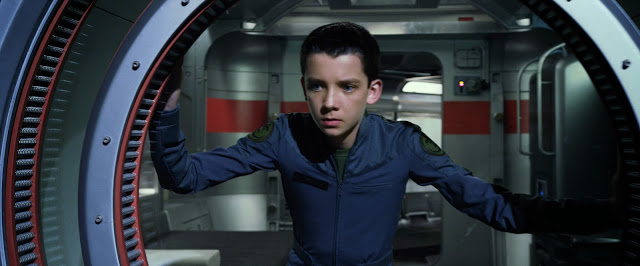
“We wanted to show the vulnerability of Ender Wiggin [Asa Butterfield] at the onset. To get the true, deep emotional impact of the story, we must see him as a child. I was mindful in dressing Asa to ensure that the tailoring and fit of the clothing showed how slight he was. Ender’s greatest asset is his mind, not his physical strength, or lack of it.”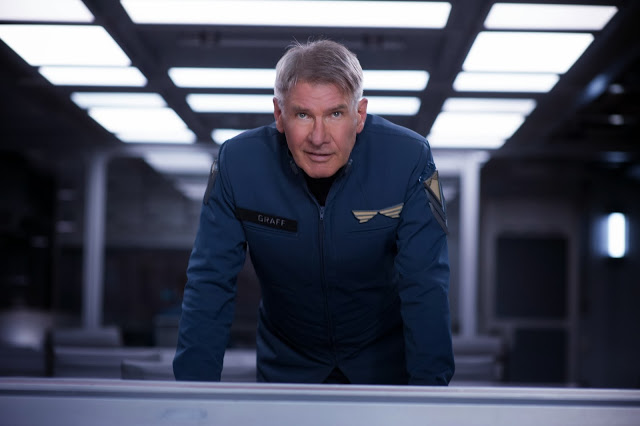
“Graff [Harrison Ford] is a force to be reckoned with and the intent was to make him as impressive and dominant of a presence at the off set. Again, tailoring is key here, to create a flat clean front/chest line and a strong shoulder. The steely blue/grey colour of the uniforms creates a coolness and emotional distance for this character, showing us that Graff is not a warm paternal character for Ender.”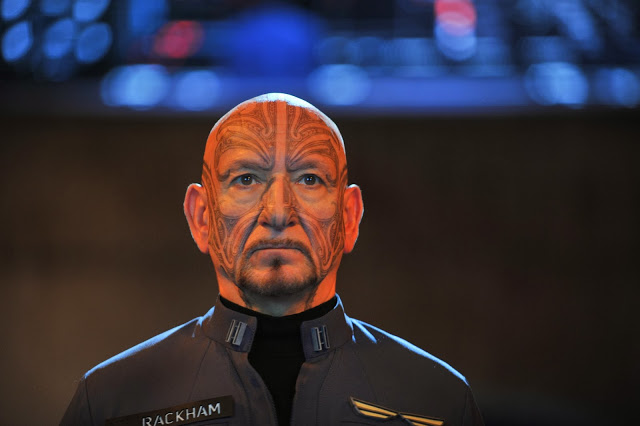
“We first see the older Rackham [Ben Kingsley] in lounge attire, in a Zen like state. We wanted to give him a costume that conveyed a quietness of the mind, had an international feeling and still felt like it was a uniform. The kurta style tunic with a stiffer collar that frames the face does just that.” 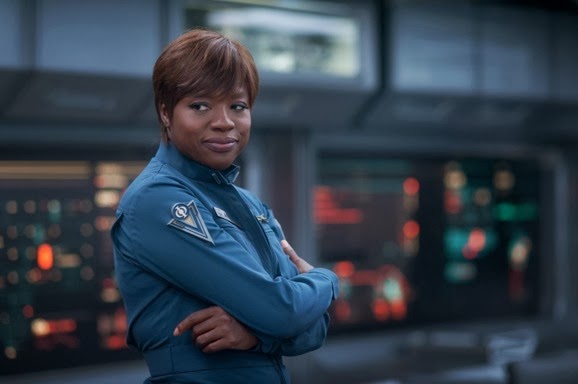

“There is a moment when Petra [Hailee Steinfield] is speaking with Ender as a Hologram, a la Princess Leia. We put her in the same military issue costume that Rackham wears in his chambers but here; it is soft, feminine, ethereal, and beautiful.” 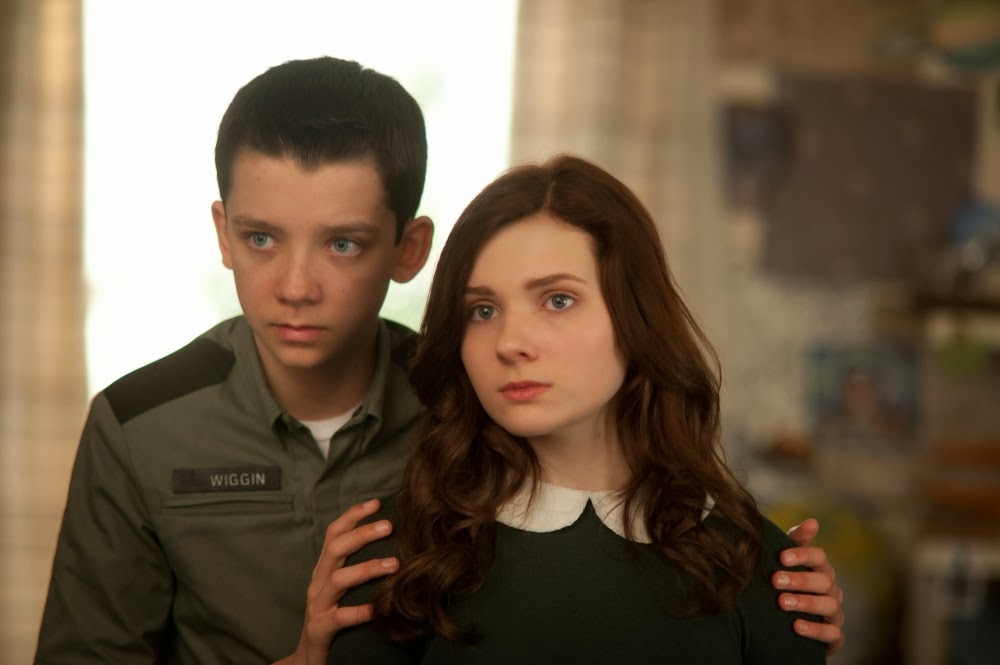
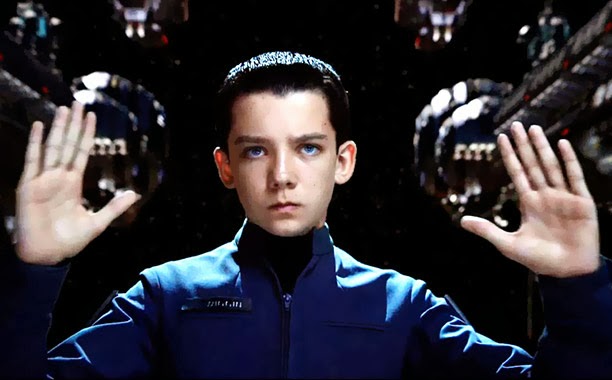
A literally huge task was dressing cast member Nonso Anozie (The Grey) who portrays Sergeant Dap. “What a lovely man! I needed a step stool in the fitting room just to be able to see and pin the alterations. Nonso is wearing the same military issue uniform as Graff and Rackham do but with a lot more fabric.” Christine Bieselin Clark observes, “The biggest challenge overall was the sheer scope of what we had to achieve in the time that we had to do it in. This is a purely designed and built film, meaning that the majority of what we see on film was sketched, illustrated, sampled, fabric was sourced and then we built the costumes, fit them, altered and finished them – for everyone, even the background. The best solution for overcoming the obstacle of time and volume was to handpick an amazing team of costume artists to work with me to achieve the seemingly impossible. My fearless Assistant Designers [Dorotka Sapinska & Alexandra Casey], Costume Supervisor [Dan Moore], and a full team of costumers in Los Angeles and New Orleans who jumped in feet first and were committed to making this work. My success was hinged on their efforts – so putting together that team was my best achievement on EG.” There were no surprises with the costumes. “What you see is fully strategized from conception to the final product, warts and all.” Bieselin Clark adds, “Ender’s Game was a labour of love for me. The story of Ender is one that we as humans can benefit from understanding. I hope that even in my small way, I was able to enrich that experience for the audience.”
“The biggest challenge overall was the sheer scope of what we had to achieve in the time that we had to do it in. This is a purely designed and built film, meaning that the majority of what we see on film was sketched, illustrated, sampled, fabric was sourced and then we built the costumes, fit them, altered and finished them – for everyone, even the background. The best solution for overcoming the obstacle of time and volume was to handpick an amazing team of costume artists to work with me to achieve the seemingly impossible. My fearless Assistant Designers [Dorotka Sapinska & Alexandra Casey], Costume Supervisor [Dan Moore], and a full team of costumers in Los Angeles and New Orleans who jumped in feet first and were committed to making this work. My success was hinged on their efforts – so putting together that team was my best achievement on EG.” There were no surprises with the costumes. “What you see is fully strategized from conception to the final product, warts and all.” Bieselin Clark adds, “Ender’s Game was a labour of love for me. The story of Ender is one that we as humans can benefit from understanding. I hope that even in my small way, I was able to enrich that experience for the audience.”



